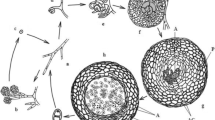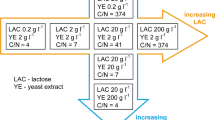Abstract
We investigated the growth and the cell lipid composition of the mycelium and of the yeast-like form of Mucor hiemalis VKMF-1431 obtained under aerobic conditions by treatment with the morphogenetic agents itraconazole, exogenous triacylglycerols (TAGs), and trehalose. The sporangiospores of a 20-day culture were inoculated on the medium with glucose. Under these conditions, the fungus produced both mycelium and yeast-like cells. It was established that, upon the germination of old (20-day) sporangiospores, the fungus predominantly used the mycelium development strategy in the presence of trehalose and TAGs. It was characterized by a low ratio between the two bulk membrane lipids (PEA/PC) and increased levels of PC and polyunsaturated fatty acids (FA). Compared to the mycelium, the yeast cell morphotype obtained on the medium with glucose was distinguished by an elevated PEA/PC ratio, lowered TAG, free sterol (FS) and esterified sterol (ES) levels, a decreased ES/FS ratio that correlated with the reserve sterol pool size, and a lowered content of unsaturated fatty acids (the linoleic and the γ-linolenic acid). These peculiarities of the lipid composition of yeastlike cells correlated with the intensity of yeastlike growth. Light and electron microscopy revealed differences between the above cell morphotypes. With itraconazole, yeast-like cells were characterized by the destruction of the endoplasmic reticulum membranes and formation of a large number of vacuoles. The suggestion was confirmed that the state/age of inoculum sporangiospores exerts an influence on the capacity for dimorphism in mucorous fungi such as M. hiemalis. The data obtained testify to an involvement of lipids in the process of adaptation to environmental factors and to their regulatory role in morphogenetic processes associated with the formation of alternative morphotypes of the mucorous fungus.
Similar content being viewed by others
References
Mysyakina, I.S. and Funtikova, N.S., Changes in the Lipid Composition of Mucor hiemalis Sporangiospores Related to the Age of the Spore-Forming Culture, Microbiology, 2003, vol. 72, no. 4, pp. 461–465.
Funtikova, N.S. and Mysyakina, I.S., Sporangiospores of the Fungus Mucor lusitanicus 12M: Correlation between Lipid Composition, Viability, and Morphology of Growth upon Germination, Microbiology, 2003, vol. 72, no. 6, pp. 686–689.
Mysyakina, I.S. and Funtikova, N.S., Sterols of the Fungus Mucor hiemalis Sporangiospores, Microbiology, 2003, vol. 72, no. 6, pp. 762–763.
Funtikova, N.S. and Mysyakina, I.S., The Dependence of Dimorphism in the Fungus Mucor lusitanicus 12M on the Preparation Conditions of Sporangiospores, Microbiology, 2004, vol. 73, no. 6, pp. 734–736.
Funtikova, N.S. and Mysyakina, I.S., Effects of Conditions for Obtaining Sporangiospores of the Inoculum on the Morphology and Productivity of the Fungus Mucor circinelloides var. lusitanicus 12 M, a Producer of γ-Linolenic Acid, Appl. Biochem. Microbiol., 2008, vol. 44, no. 4, pp. 411–415.
Mysyakina, I.S., Sergeeva, Ya.E., Ivashechkin, A.A., and Feofilova, E.P., Lipid Composition of the Mycelium of the Fungus Mucor hiemalis Cultivated with Trehalose, Triacylglycerols, and Itraconazole, Microbiology, 2012, vol. 81, no. 6, pp. 669–675.
Lucio, A.K.B., Polizeli, M.L.T.M., Jorge, J.A., and Terenzi, H.F., Stimulation of Hyphal Growth in Anaerobic Cultures of Mucor rouxii by Extracellular Trehalose. Relevance of Cell Wall-Bound Activity of Acid Trehalase for Trehalose Utilization, FEMS Microbiol. Lett., 2000, vol. 182, pp. 9–13.
Vanden Bossche, H., Importance and Role of Sterols in Fungal Membranes, in Biochemistry of Cell Walls and Membranes in Fungi, Kuhn, P.J., Trinci, A.P.J., Jung, M.J., Goosey, M.W., and Copping, L.G., Eds., Berlin: Springer, 1990, pp. 135–157.
Klose, J., de Sa, M.M., and Kronstad, J.W., Lipid-Induced Filamentous Growth in Ustilago maydis, Mol. Microbiol., 2004, vol. 52, no. 3, pp. 823–835.
Bartnicki-Garcia, S., Symposium on Biochemical Bases of Morphogenesis in Fungi. III. Mould-Yeast Dimorphism of Mucor, Bacteriol. Rev., 1963, vol. 27, pp. 293–304.
Sypherd, P.S., Borgia, P., and Pasnokas, J.L., Biochemistry of Dimorphism in the Fungus Mucor, Adv. Microb. Physiol., 1978, vol. 18, pp. 67–104.
Van Laere, A., Trehalose, Reserve and/or Stress Metabolite?, FEMS Microbiol. Rev., 1989, vol. 63, pp. 201–210.
Wiemken, A., Trehalose in Yeast, Stress Protectant rather Than Reserve Carbohydrate, Antonie van Leeuwenhoek Int. J. Gen. Mol. Microbiol., 1990, vol. 59, pp. 209–217.
Dippe, M. and Ulbrich-Hofmann, R., Phospholipid Acylhydrolases Trigger Membrane Degradation during Fungal Sporogenesis, Fungal Genet. Biol., 2011, vol. 48, pp. 921–927.
Folch, G., Lees, M., and Sloane-Stanley, G.H., A Simple Method for the Isolation and Purification of Total Lipids from Animal Tissues, J. Biol. Chem., 1957, vol. 226, no. 1, pp. 497–509.
Higashiyama, T., Novel Functions and Applications of Trehalose, Pure Appl. Chem., 2002, vol. 74, pp. 1263–269.
Funtikova, N.S., Mysyakina, I.S., and Poglazova, M.N., Morphogenesis and Lipid Composition of Mucor Fungi Grown in the Presence of Chloroanilines in Submerged Culture, Microbiology, 1999, vol. 68, no. 4, pp. 406–411.
Author information
Authors and Affiliations
Corresponding author
Additional information
Original Russian Text © I.S. Mysiakina, Ya.E. Sergeeva, A.A. Ivashechkin, E.P. Feofilova, 2012, published in Mikrobiologiya, 2012, Vol. 81, No. 6, pp. 733–740.
Rights and permissions
About this article
Cite this article
Mysiakina, I.S., Sergeeva, Y.E., Ivashechkin, A.A. et al. Impact of morphogenetic effectors on the growth pattern and the lipid composition of the mycelium and the yeastlike cells of the fungus Mucor hiemalis . Microbiology 81, 676–683 (2012). https://doi.org/10.1134/S0026261712060100
Received:
Published:
Issue Date:
DOI: https://doi.org/10.1134/S0026261712060100




